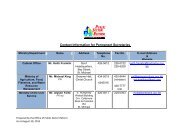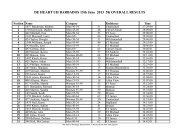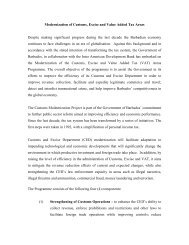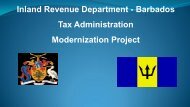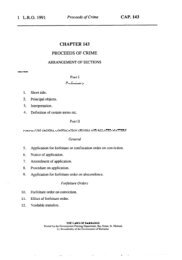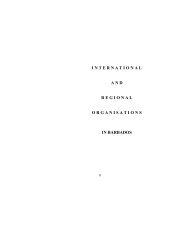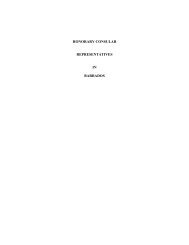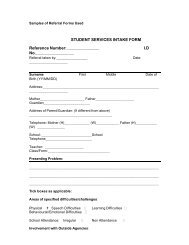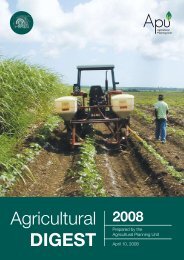Handbook for Self-employed Persons - National Insurance Scheme
Handbook for Self-employed Persons - National Insurance Scheme
Handbook for Self-employed Persons - National Insurance Scheme
You also want an ePaper? Increase the reach of your titles
YUMPU automatically turns print PDFs into web optimized ePapers that Google loves.
THENATIONAL INSURANCE SCHEMESELF EMPLOYEDH A N D B O O Kwww.nis.gov.bb
03Payment of Contributions and Levies by <strong>Self</strong>-Employed <strong>Persons</strong>It is compulsory <strong>for</strong> self-<strong>employed</strong> persons to be insured and contributions are payable quarterly.Payments must be made on the Contributions Schedule and Payment Certificate provided bythe <strong>National</strong> <strong>Insurance</strong> Office. (See Contributions Schedule and Payment Certificate at Annex 2).Contributions should be paid within fifteen (15) days after the end of the calendar quarter <strong>for</strong>which they are due. Failure to pay at the proper time will result in a penalty <strong>for</strong> late payment in the<strong>for</strong>m of interest at the rate of one per cent per month.Contributions and training levy are payable on insurable earnings up to a maximum of $3,900 permonth <strong>for</strong> persons between age 16 and pensionable age, while <strong>for</strong> those persons under 16 andover pensionable age only pay the training levy of 0.5% and the catastrophe fund of 0.1%.Contributions and levy are made up as follows:-2007 2008 2009 % % % <strong>National</strong> <strong>Insurance</strong> 13.50 13.50 13.50Non-contributory 2.00 2.00 2.00Training Fund 0.50 0.50 0.50Catastrophe Fund 0.10 0.10 0.10TOTAL 16.10 16.10 16.10 Contributions payable by a self-<strong>employed</strong> person are based on his/her earnings from self-employment, during the period of one year immediately preceding the contribution year in whichthe contribution is due. However, where the person has been self-<strong>employed</strong> <strong>for</strong> less than a year,or where he/she asks the Board to do so or where it so decides, the <strong>National</strong> <strong>Insurance</strong> Boardwill determine the rate of contribution. For these purposes the Board may require evidence ofearnings.
04Voluntary ContributionsA self-<strong>employed</strong> person on ceasing employment may apply to the <strong>National</strong> <strong>Insurance</strong> Board tobecome a voluntary contributor when he has paid at least 150 contributions as an <strong>employed</strong> orself-<strong>employed</strong> person (the contributions may be a mixture of both). <strong>Self</strong>-<strong>employed</strong> persons onbecoming voluntary contributors continue to contribute <strong>for</strong> old age contributory grant or pensionand survivors’ benefit only.The Board determines the rate of contributions payable by a voluntary contributor.Exemption from Liability <strong>for</strong> ContributionsA self-<strong>employed</strong> person may be exempted from liability to pay contributions <strong>for</strong> any period whenhe/she is not in receipt of an income exceeding $1,092 a year.A person desiring to be so exempted must make an application to the Board <strong>for</strong> that purpose.Benefits<strong>Persons</strong> must claim all benefits to which they have entitlement promptly. If someone is unsurewhether he/she has title to a benefit, he/she should submit a claim.Sickness BenefitA self-<strong>employed</strong> person may qualify <strong>for</strong> sickness benefit provided that:a) he/she has paid not less than 7 contributions in the contribution quarter 1 but one be<strong>for</strong>e thecontribution quarter in which he/she became ill;b) he/she has been insured <strong>for</strong> not less than 13 contribution weeks; andc) he/she must have not less than 39 contributions paid or credited to his/her account in the fourconsecutive quarters ending with the quarter but one 2 be<strong>for</strong>e the contribution quarter in whichincapacity commenced.1A calendar year is divided into four contribution quarters of three months each, ending on 31 st March, 30 th June, 30 th September, and 31 st December.2Quarter but one refers to the contribution quarter preceding the one falling immediately be<strong>for</strong>e the contribution quarter in which the incapacity occurred.
05How is the Sickness Benefit Computed?The daily rate of sickness benefit is 66 2/3 % of the insured person’s average insurable weeklyearnings, divided by 6.Average insurable weekly earnings means the sum of the insurable earnings 3 on whichcontributions were based over the contribution quarter but one be<strong>for</strong>e the contribution quarter inwhich the first day of the continuous incapacity <strong>for</strong> work commenced divided by the number ofweeks in that quarter.Two or more periods of illness, which are not separated by more than 13 weeks, are treated asone continuous period of illness, and the rate of benefit payable <strong>for</strong> the whole period is the ratepayable during the first period of illness.Sickness benefit is payable <strong>for</strong> each day of illness, excluding Sundays, subject to a maximum of26 weeks in any continuous period of illness. However, where a person has been engaged inemployment <strong>for</strong> 150 contribution weeks and has 75 contributions paid or credited to his accountin the three complete contribution years immediately prior to commencement of incapacity,sickness benefit may be paid <strong>for</strong> a further 26 weeks.The first three (3) days of a period of incapacity are treated as “waiting days” and benefit is notpayable <strong>for</strong> these days, unless the incapacity lasts <strong>for</strong> 2 weeks or more.Sickness benefit is not payable if a person is out of the island unless the person has gone abroadtemporarily <strong>for</strong> the purpose of receiving medical treatment <strong>for</strong> an illness that commenced be<strong>for</strong>ehe/she left Barbados. The department should be notified of any such visit.Maternity BenefitFor a self-<strong>employed</strong> person to qualify <strong>for</strong> maternity benefit, the following conditions must besatisfied:a) she must have not less than 39 contributions paid or credited to her account in the four (4) consecutivequarters ending with the quarter but one be<strong>for</strong>e the contribution quarter in which benefit couldbecome payable;b) she must have paid at least 16 contributions in two contribution quarters but one be<strong>for</strong>e thecontribution quarter in which the benefit could become payable.3 Any earnings of an insured person as set out in the Schedule to the Collections of Contributions Regulations
06Payment of Maternity BenefitThe daily rate of maternity is 100% of the insured person’s average insurable weekly earnings,divided by 6.Average insurable weekly earnings means the sum of the insurable earnings on which contributionswere based over the two contribution quarters but one be<strong>for</strong>e the contribution quarter in whichmaternity benefit is payable divided by the number of weeks in the quarters.If at the end of the maternity benefit period the insured person is incapable of work becauseof pathological complications of confinement 4 , sickness benefit may be paid provided that onthe first day from which maternity benefit was payable the insured person had title to sicknessbenefit.Maternity benefit is not payable to a person who is out of the island unless that person has gone<strong>for</strong> the purpose of receiving medical attention. The department should be notified of any suchvisit.Maternity GrantA self-<strong>employed</strong> woman may qualify <strong>for</strong> a Maternity Grant if: -a) she does not satisfy the contribution conditions <strong>for</strong> Maternity Benefit;b) the woman’s spouse has been an insured person and has paid the requisite number of contributionsthat would have enabled the woman to qualify had they been paid by her.Amount of Maternity GrantThe amount payable as a Maternity Grant 5 is $995. It may only be claimed by the woman whohas had a confinement. For purposes of a Maternity Grant, “spouse” includes a single man whois living together with a single woman <strong>for</strong> a period of not less than 2 years or 1 year plus nameas father on child’s birth certificate. “Single man” and “single woman” includes a widower and awidow respectively.4 Childbirth resulting in the issue of a living child or childbirth after 28 weeks of pregnancy resulting in the issue of a child, whetheralive or dead.5 A lump sum of money issued in settlement of a benefit.
08where increases are granted, and a minimum pension of $155.00 per week. For self-<strong>employed</strong>persons the average annual contributions must be 39.Invalidity pension continues in payment so long as invalidity lasts. However, if invalidity continueswhen the insured person reaches pensionable age, the invalidity pension is converted into an oldage contributory pension of an equal amount. Invalidity benefit may be paid whilst the recipientis living abroad. Additionally, if a person qualifies <strong>for</strong> an invalidity pension, an invalidity grant isnot payable.Invalidity GrantAn invalidity grant is payable to an insured person who has failed to qualify <strong>for</strong> an invaliditypension but who satisfies the following requirements:a) he/she must be under pensionable age;b) he/she must be permanently incapable of undertaking further employment because of a specificdisease or bodily or mental disablement;c) he/she must have at least 50 contributions paid or credited to his/her account.The amount of an invalidity grant is a lump sum equal to 6 weeks average insurable weeklyearnings <strong>for</strong> each 50 contributions actually paid or credited to the insured person’s account.Average insurable weekly earnings <strong>for</strong> the purpose of an invalidity grant is the sum of theinsurable earnings on which contributions were based, divided by the number of weeks ofcontributions.Old-Age Contributory BenefitOld-age Contributory Benefit may either be a Grant or pension. If a person qualifies <strong>for</strong> an Old-ageContributory Pension an Old-age Contributory Grant is not payable.As a result of Pension Re<strong>for</strong>m and the introduction of flexible NIS retirement/pensionable ages,persons may retire on an NIS pension at any age from 60 to 70. To ensure that there is no financialadvantage as a result of choice of retirement age; persons opting <strong>for</strong> early retirement will receivea reduced pension.
09Late retirement up to a limit of age 70 would result in increases in pension at a percentage equalto the rate of decrease <strong>for</strong> persons opting <strong>for</strong> early retirement. The adjustment rate has been set at0.5% <strong>for</strong> each month earlier or later than the NIS pensionable age.A person’s pension at pensionable age is not tied to retirement. Pensionable age is currently 66 yearsfrom 1 st January 2010 and will remain so until 31 st December 2013. Thereafter pensionable age willincrease by 6 months every 4 years until it reaches 67 years on 1 st January 2018.NIS Pensionable AgesPrior to 1 January, 2006 651 January, 2006 to 31 December, 2009 65 ½ years1 January, 2010 to 31 December, 2013 66 years1 January, 2014 to 31 December, 2017 66 ½ years1 January, 2018 and after 67 yearsOld-Age Contributory GrantTo qualify <strong>for</strong> old age contributory grant: -a) the person must have attained pensionable age;b) he/she must have at least 50 contributions paid or credited to his/her account.The amount of an old-age contributory grant is a lump sum equal to 6 weeks average insurableweekly earnings <strong>for</strong> each 50 contributions actually paid or credited to the insured person’saccount.Average insurable weekly earnings <strong>for</strong> the purpose of an old-age contributory grant is the sumof the insurable earnings on which contributions were based, divided by the number of weeks ofcontributions.
10Old-Age Contributory PensionThe Old-age Contributory Pension is now available at ages ranging from:a) The NIS pensionable age – currently 66 years;b) Voluntary pensionable age – any age below the pensionable age as low as age 60c) Late retirement age – any age after the NIS pensionable age but up to 70 yearsIn addition, to qualify <strong>for</strong> NIS pension one must:a) have at least 150 contributions actually paid to one’s accountb) have at least a total of 500 contributions paid or credited to one’s account.How is Old-Age Contributory Pension Computed?There are currently 3 bases <strong>for</strong> calculating NIS Pension. The calculations are based on the age of theperson applying <strong>for</strong> pension at 31 December 2002. For persons aged 56 or over on 31 December2002, their pension would be calculated using the old basis. For persons under 47 years at 31December 2002, their pension would be calculated using the new basis. For persons aged 47 andover but less than 56 years on 31 December 2002, their pension would be calculated using 50%new and 50% of the old basis. To be put otherwise, persons born on or be<strong>for</strong>e 31 December 1946will stay on the old basis. Those born on 1 January, 1956 or later go to the new basis. All those inbetween go on the 50/50 basis.Old BasisThe annual rate of pension is 40% of the average annual insurable earnings of the insuredperson, supplemented by 1% of the total insurable earnings on which contributions were basedsubsequent to the first 500 contributions paid or credited, but subjected to a maximum of 60%of average annual insurable earning (at pensionable age), and a minimum pension of $155.00per week.
11Average annual insurable earnings <strong>for</strong> the purpose of an old-age contributory pension is the sumof the insurable earnings on which contributions were based during the best five contributionyears of the insured person’s contribution life, divided by 5. Where the contribution years are lessthan fifteen, the total number of contribution years will be used.New BasisUsing the new basis the pension is calculated based on the number of years of contributions andthe annual average insurable earnings over the best five years. The pension is computed by finding2% of the average annual earnings <strong>for</strong> the first 20 years and then finding 1 ¼ % of the remainingyears. This pension is also capped at 60% of the average annual insurable earnings.Supplemental PensionThe supplemental pension is computed by totalling the insurable earnings represented by thecontributions in excess of the first 500 and finding 1% of the amount.Maximum PensionThe maximum pension, that is, the basic pension plus supplemental pension, may not exceed60% of the average annual insurable earnings.Here’s how to work it out . . .The old basis computation is as follows:Contribution weeks1,100 weeks (22 years)Annual average (best 5 years) $35,500Aggregate earnings after first 500 $426,000Basic annual pension ($35,500 x 40%) = $14,200Supplementary pension $426,000 x 1% = $4,260Total annual pension $14,200 + $4,260 = $18,460Weekly Pension = $18,460/52 = $355
12The new basis computation is as follows:Contribution weeks1,100 weeks (22 years)Annual average (best 5 years) $35,5002% <strong>for</strong> each year <strong>for</strong> first 20 years and 1 ¼ % <strong>for</strong> all subsequent years.20 x 2% x $35,500 = $14,2002 x 1 ¼ % x $35,500 = $887.50Total annual pension = $14,200 + $887.50= $15,087.50Weekly Pension = $15,087.50/52 = $290.14The 50/50 basis is as follows:½ of the “Old Basis” total + ½ of the “New Basis” total½ of $355 + ½ of $290.14= $177.50 + $145.07= $322.57Early & Late PensionThe examples shown above are the calculations <strong>for</strong> a person who would receive his/her pensionat the pensionable age (66). The two examples below show the computation if this same personwere to take either early or late pension.Adjustment <strong>for</strong> early pension:In order to qualify <strong>for</strong> an early pension one must have actually retired from employment. It shouldalso be noted that a person qualifying <strong>for</strong> the minimum pension would not be allowed to claim anearly retirement pension, as that would reduce the payment below the minimum standard.In the first example above, the resulting pension payable at pensionable age was $355 per week.If a pensioner opted <strong>for</strong> early retirement pension at age 64 years 3 months, the following wouldapply:Age at effective claiming date = 64 years 3 monthsNo. of months early= 21 monthsReduction factor = 21 months x 0.5% per month = 10.5%Pension deduction = $355 x 10.5% = $37.28Net weekly pension = $355.00 - $37.28= $317.72
13This reduced pension is payable <strong>for</strong> life unless the pensioner is re-<strong>employed</strong>.Adjustment <strong>for</strong> late retirement pension:If the pensioner had deferred receipt of the pension to age 66 years 8 months, the followingadjustment would apply:Age at effective claiming data = 66 years 8 monthsNo. of months late = 8 monthsLate retirement factor =8 months x 0.5% per month = 4%Pension increase = $355.00 x 4% = $14.20Increased weekly pension = $355.00 + $14.20 = $369.20Survivors’ BenefitSurvivors’ Benefit may either be a grant or pension.A surviving spouse and children of a deceased insured person qualify <strong>for</strong> a survivors’ benefit, ifthe deceased at the time of death was receiving or was qualified to receive invalidity or old agecontributory benefit.If the deceased had qualified <strong>for</strong> a grant, the survivors’ benefit would be a grant or lump sumpayment.If the deceased had qualified <strong>for</strong> a pension, the survivors’ benefit would be in pension <strong>for</strong>m.Children and Survivors’ BenefitsChildren who qualify <strong>for</strong> a survivors’ benefit are all unmarried children including adopted childrenand step-children who at the date of the parent’s death were living with or were wholly or mainlymaintained by the parent.Survivors’ pension is payable in respect of a child until his 16th birthday. Where the child is in fulltime education at an approved educational institution, a survivors’ pension is payable until his/her25th birthday.If a child is an invalid he retains his qualification <strong>for</strong> survivors’ benefit so long as invalidity lasts.
14Spouses and Survivors’ BenefitsA common-law spouse may be treated as a surviving widow/widower when no legal spouseexists.A spouse, 50 years of age or over, who had been married to the deceased <strong>for</strong> not less than three(3) years at the time of the partner’s death qualifies <strong>for</strong> a pension <strong>for</strong> life or until he/she becomesentitled to a pension in his/her own right at a higher rate.A spouse of 45 years or over in age and had been married to the deceased <strong>for</strong> not less than 3years at the time of the person’s death shall qualify <strong>for</strong> a survivors pension <strong>for</strong> life or until he/shebecomes entitled to a pension in his/her own right at a higher rate.However, survivors’ benefit is payable <strong>for</strong> only one (1) year in respect of a marriage contractedafter an insured person had been granted an invalidity or old age contributory pension and 3 yearsor more be<strong>for</strong>e death of the insured person.An invalid spouse below the age of 50 who had been married <strong>for</strong> not less than three years at thetime of the partner’s death qualifies <strong>for</strong> a pension during the period of invalidity.All other spouses qualify <strong>for</strong> a pension <strong>for</strong> one year. Payments to survivors cease on marriage,remarriage or cohabitation as man and wife.How is Survivors’ Benefit Computed?Survivors’ benefit payable to a widow/widower who at the time of the death of the insured was50 years or over and married <strong>for</strong> at least 3 years would be entitled to a pension of one half ofthe amount which would have been payable as invalidity or old age contributory benefit to thedeceased spouse had he/she been alive.For spouses 45 years and over they would be entitled to a pension of one-third of the maximumpension available <strong>for</strong> payment to survivors.Survivors’ benefit payable to a child is one-sixth of the amount, which would have been payableto the parent had he/she been alive. However, if a child is an orphan or an invalid, he/she mayreceive one-third.
15Where no spouse is entitled to survivors’ benefit, the full amount of survivors’ benefit may be paidin respect of children of the deceased.In no case can the total survivors’ benefit payable exceed the amount which would have beenpayable to the deceased person at the time of his/her death.Duplication of BenefitsAs a general rule where a person is entitled to more than one benefit at the same time, only onebenefit is payable. The benefit payable is the one first awarded or one subsequently awarded ifthe subsequent benefit is at a higher rate. However, there is provision <strong>for</strong> full duplication of certainbenefits as follows:a) sickness or maternity with survivors’ benefit;b) funeral grant with any other benefit.
ANNEX
Annex 1Front
Annex 1Back
Annex 2




